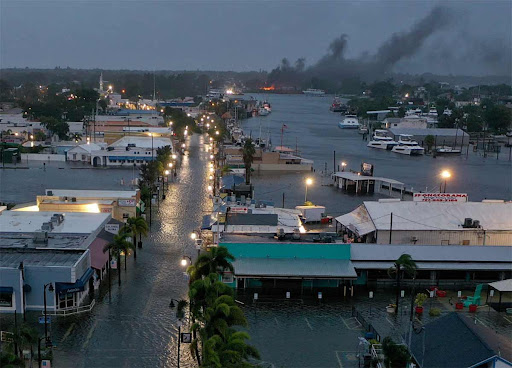Coastal North Carolina, with its exquisite natural beauty, is a region of dualities. Beneath the serene facade lies an ever-present vulnerability to the ferocity of Atlantic storms. Historically, hurricanes like Florence, Dorian, and Isaias have challenged the region’s resilience.
As we reflect on the aftermath of these storms, we uncover stories of determination and the broader implications for storm-prone regions worldwide. Coastal North Carolina serves as a compelling example of the enduring importance of readiness and the unwavering human spirit in the face of nature’s fiercest trials.
Lessons Learned from Recent Storms
 Image Source: WUNC
Image Source: WUNC
Below are the most crucial lessons Coastal North Carolina has learned from these recent tempests.
A. Evacuation strategies and their effectiveness: Recent storms revealed challenges in timely evacuations, highlighting the need for clear, well-organized plans and improved communication to ensure safe evacuations.
B. Infrastructure resilience and vulnerabilities: The storms exposed strengths and weaknesses in Coastal North Carolina’s infrastructure. This underscores the importance of enhancing construction standards and upgrading vital systems like power grids and flood control.
C. Community response and support systems: Community bonds and volunteer efforts shone brightly during recent storms, emphasizing the need for resilient communities that can effectively support each other during crises.
D. The role of technology in storm preparedness and response: Technology has become a crucial tool in mitigating storm impacts, from advanced weather forecasting to early warning systems. Recent experiences underscore the importance of ongoing technology investments for better preparedness and response, aiding in safeguarding lives and property.
Environmental and Ecological Consequences
Recent storms have profoundly impacted Coastal North Carolina’s delicate ecosystems and wildlife. Erosion and disruption of habitats, such as wetlands and marshlands, have repercussions for both plant and animal species, unsettling the region’s environmental equilibrium. Moreover, storms introduce pollutants and debris, endangering aquatic life and water quality, underlining the importance of conservation efforts.
The lessons from recent storms underscore the pressing concern of climate change. Warming oceans contribute to more potent hurricanes, heightening the region’s vulnerability. Rising sea levels and unpredictable weather patterns necessitate climate-conscious storm preparedness, involving sustainable development, floodplain management, and habitat preservation to enhance resilience against the evolving climate and its associated storms.
Community Resilience and Adaptation
 Image Source: News 3
Image Source: News 3
Recent storms have spurred the creation of community emergency response teams and drills, empowering residents to engage in disaster response and evacuation procedures actively. Public engagement in understanding evacuation orders and safety protocols is crucial.
By educating residents about risks, preparedness, and timely evacuation, Coastal North Carolina enhances individual and community safety while reducing the strain on emergency responders. This approach empowers residents to take an active role in securing their lives and their communities during storms.
Government and Policy Responses
In the wake of recent storms, government disaster response and management have played a central role in safeguarding Coastal North Carolina’s residents. From issuing timely evacuation orders to efficiently deploying first responders and allocating resources, these efforts are instrumental in protecting lives.
The adaptability and coordination across federal, state, and local agencies have emerged as crucial factors, emphasizing the importance of a flexible response system that can address the unique challenges posed by each storm event. These lessons underline the imperative of remaining agile in the face of unpredictable natural forces.
The lessons from recent storms have catalyzed significant policy changes in Coastal North Carolina, which are geared towards enhancing storm preparedness and recovery. These policy shifts encompass improvements in infrastructure, floodplain management, and a renewed focus on environmental conservation.
They advocate for resilient construction standards, sustainable development practices, and a proactive approach to addressing climate change considerations, such as shifting weather patterns and rising sea levels. These policy changes are not just theoretical but the foundations of Coastal North Carolina’s preparedness for future storms in an ever-changing climate, ensuring a more resilient and secure future.
The Road Ahead: Mitigation and Future Readiness
Coastal North Carolina is committed to reducing vulnerability through resilient construction, advanced early warning systems, and green infrastructure initiatives that act as natural storm barriers.
Planning for the future involves climate adaptation, emphasizing sustainable building practices, habitat conservation, and resilience against rising sea levels and changing weather patterns. These initiatives aim to strike a balance between economic growth and environmental protection, ensuring greater preparedness for storms in the face of a changing climate.
Final Thoughts
In the heart of Coastal North Carolina, where the magnificence of nature meets the fury of storms, the lessons learned from recent tempests resonate deeply. The region, etched with a history of resilience, has responded to these challenges with a commitment to bolster its readiness, from community-level preparedness to government responses and forward-thinking policies.
These storms have imparted wisdom in the realms of evacuation, infrastructure, and climate adaptation, revealing the significance of adaptability and proactive mitigation. The region’s bond with its ecosystems and wildlife is undeniably precious, emphasizing the need for conservation efforts as it navigates the consequences of storm-induced disruptions.
As Coastal North Carolina charts its path to the future, the strategies of resilience, climate adaptation, and sustainable development are the guiding stars. The region, an emblem of determination, stands as a testament to the enduring spirit of humanity when confronted by the might of nature.
In the face of impending storms and an evolving climate, these lessons are not just for Coastal North Carolina but for all regions confronting the unpredictable forces of nature. They remind us that preparedness, adaptability, and resilience are the foundations of a safer and more sustainable future.



Leave a Reply